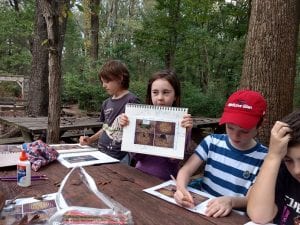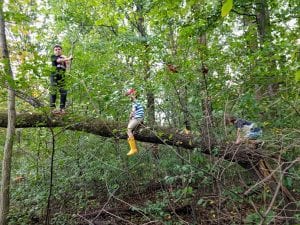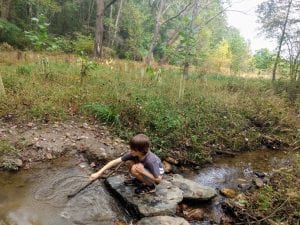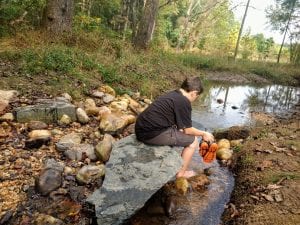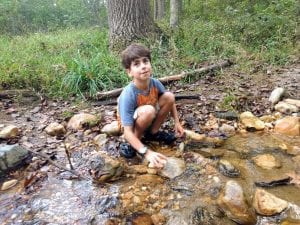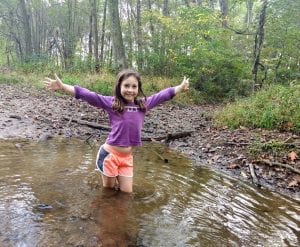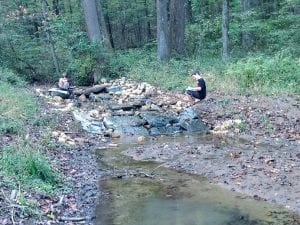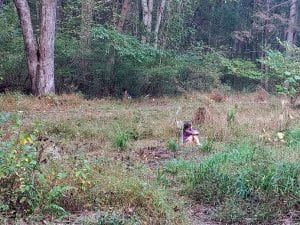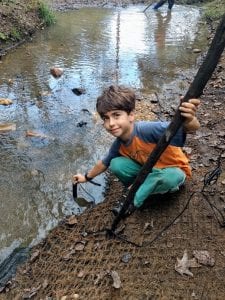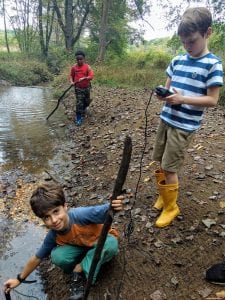10/9/2018
With fall in full swing we introduced a new leaf artist to our repertoire, James Brunt. He uses leaves and other natural materials to create patterns on the forest floor. He takes photos of his creations to sell as art and they are beautiful! Check out some of his amazing art here: https://www.jamesbruntartist.co.uk/
We had four of his art pieces in our journals, three were leaf patterns, some incorporated sticks and another used acorns and oak leaves (see below). We looked over the art, numbered our favorites, thought of our own names for the art and shared our thoughts. The piece with the leaves placed in a circle Alden said the swirl looked like a hypnotizing circle. Fiona described the one with the acorns and oak leaves as a tiny fairy village. Shama liked the one with the sticks between the leaves and he described it as looking like a cracked rock. The different James Brunt leaf art we examined is pictured below:
We hiked to the gazebo under the canopy of falling leaves and enjoyed snack. After snack we gathered some interesting leaves and did some leaf rubbings in our journals. Placing the leaf behind a thin piece of paper with the bumpy side up and using a paperless crayon on its side, you can create some amazing, instant leaf art! After doing our leaf rubbings and labeling the species of tree the leaf came from in our journal, we enjoyed some tree climbing nearby.
With a long hike in front of us, we headed toward the hidden forest ponds. We hiked along a slippery, wet boardwalk over a wetland. We spent some time exploring the ponds before finding our spots to sit and either think, watch, listen and/or journal during a sit spot. Sit spots are great ways to allow people time to themselves to ground themselves in a place and also make connections. These connections can be hearing new nature sounds, finding something nearby them that they otherwise wouldn’t have seen, journaling about something they are thinking about and so on. We spent 5 minutes in our own spots and then came back as a group and shared some of our experiences from our sit spots. Fiona thought the time just flew by and felt shorter than 5 minutes, Shama found a toad during his sit spot, Naftali liked the look of the water as it moved over the rocks and Alden noticed fish going down the small waterfalls from the stream to the pond.
We also had a quick group discussion about our dam and bridge building from the previous week. We want to do another dam and bridge and were hoping to brainstorm some ways to improve our design. First we described our observations from the dam, that the dam created a pool of water, made the creek wider and raised the water level. We were wondering if our creations were considered art and thought yes and no, yes because it was created by us and art is man made but also no because it’s not really traditional artwork. One way we can make the dam better is by building it in a different location in the stream (more narrow section) and by using mud and leaves more to fill weaknesses in the dam where water is getting through. To wrap up our day and connect to some of the activities we did at the upper part of the stream, we got out a cool tool called a Dissolved Oxygen meter. Dissolved Oxygen is the amount of oxygen in the water. Why is that important? Well, just like us needing to breathe oxygen in the air, fish and other animals like insects and tadpoles need oxygen in the water in order to survive. We were wondering how well our water was doing. We had already found out the temperature was pretty cool (in the low 60s) and the phosphate levels weren’t too high (which is good) so how was our oxygen levels? We tested at various spots, allowing everyone to experience using the scientific tool. We noticed slightly higher oxygen levels near areas where water was tumbling over rocks (this helps mix oxygen into the water). Overall the water’s oxygen levels were very good, awesome! This is a way to explore the science of our land.
Next week we’ll do a leaf experiment and art installation and celebrate with our mid-semester campfire!



